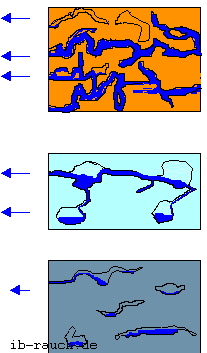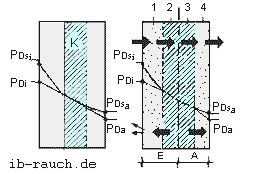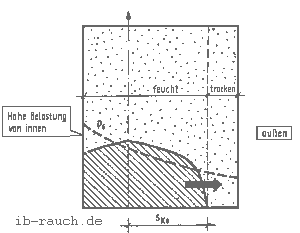Atmospheric humidity in the apartment - cause of the mold-formation |  Peter Rauch Dipl.-Ing.oec., Ing. |
Atmospheric humidity in the apartment - cause of the mold-formation |  Peter Rauch Dipl.-Ing.oec., Ing. |
1. Interaction humidity and construction-mantle
1.1. Building material and humidity
1.2. The dew-water-formation and the humidity in the brickwork
2. Atmospheric humidity in the accomodation
2.1. Humidity in apartments
2.2.-gas-steam-mixture
2.3. Heat-demand for energy - gas-mixture and heating (ventilation-replacement)
2.4. Case in point ventilation-heat-requirement at a single-family home
3. The dampness-production and the ventilation-replacement
Online-calculation - atmospheric humidity, dew point and mold-formation
A construction-mantle encloses the residential and working rooms. For an understanding of the entire problem, also this must be included in the contemplation. The relative humidity is dependent on the temperature and the absolute humidity. However, it is not alone responsible for a mold-formation. More elements work, sees estimate / calculation the mold-formation. In this contribution, it is restricted itself predominantly to the emergence and interaction of the humidity.
The saying of "constant drops hollows out reminds the stone" on it, has the water on everything parties dissolving effect and can have already low volumes large consequences at the wrong position. [1] in all capillary-porous Construction parts is stored humidity. The storage proceeds dynamically and within the same component part often very unevenly. With capillary-porous component parts, an average term-moisture-content appears. Wood is marked by a balance-humidity, however also is hygroscopic, humidity can therefore bind out of the air. One distinguishes
Water vapor-diffusion: the transportation of water vapor from the construction-material
Capillary conductivity: the transportation of fluid (water) from the construction-material
Hygroscopic: the ability of a construction-material, to pick up waters and to bind.
| Well qualified capillary-system with capillaries different diameters: Big water-reception-capability, big dampness-delivery-capability for example bricks gypsum Geschlossenzellige structure with few capillaries between the cells: Big water-reception-capability, low dampness-delivery-capability, for example gas-concrete Structure with small, closed pores and capillaries: Low water-reception-capability, low dampness-delivery-capability, for example heavy-concrete, expanded clay concrete |  |
Bricks, Clay and Wood especially favorable physical qualities have and are to be recommended for that reason as space-enclosing construction-materials. Its essential advantage is that they can reduce short-term moisture-apexes as they perform with the douche, for example. Heats insulation must be protected from direct Durchfeuchtung since its effect on many cavities with air is based. Fullness itself these with water, so the effect of the heat insulation is reduced to almost 50 per cent. Therefore these heats insulation are to be protected with a carefully appropriate steam-lock above all if an inner-heat insulation is available. With heats insulation with more highly balance-dampness, like coconut, straw, cork or cellulose, it can be given up the steam-lock conceivably. [1]
The Quantifizierung of the dampness-household of encirclement-constructions has not yet reached any satisfactory stand until now. The proof of the internal condensate-formation for example still comes diffusion-system after the little glazier, that however neither the hygroscopic one on - and discharge still the capillary relaxation of the dew-water is considered.
Further connections to the humidity in the brickwork become desiccation of moist Construction parts in the contribution represented.
A dew-water-formation takes place, if auftrifft a water-steam-mixture (air) on a less warm component part-surface. After a change of the building-mantle or component part-order as well as with another utilization, such appearances can more frequently occur. A dew-water-formation always immediately must not occur at the cooler wall-surface, however. For a slow, though continuous soaking, it already often passes a higher relative humidity to the wall-surface from, if at certain component parts over a longer time is available. Beside a low one until not all in high relative humidity should preferably all indoors lying component parts an approximately same surface temperature shows. All construction-materials as well as the equipment-objects stand in a dampness-balance by the relative humidity, that is, the humidity increases short-term, so this "dampness-apex" picks up the wall-construction-material and the equipment-objects, this is called adsorption. If the humidity sinks again, for example through ventilation, so humidity is handed (Desorption) (see picture 2) over again to the ambient air (air-steam-mixture). The bigger the plain standing to the disposal is, the share of aufzunehmenden water vapor is surface all the more inferior per qm. Presupposed, the wall-coating admits such a Sorption and a diffusion. With this procedure, however, also the effect must be taken the wall-salts and from outside penetrating dampness into account how they can occur in the cellar, for example. Into the direction of the diffusion, it is determined by the absolute dampness-salary of the air. The water vapor diffuses in direction steam pressure and temperature-descents (from indoors outside) in the winter. He/it can out-diffuse despite firm cooling on the other page of the wall without changing his/its physical state. No dew-water-formation takes place with it at the surface or in the wall-cross section. However, this changes if a dense work period is on the cold page and such a dust-empire refines where a steam-repletion-pressure is built. Then, a condensation can be caused.  If you still are additionally in the wall-setup water (condensate or other soaking), so also this tries to get out of the wall. An interconnection-FTAM process ensues rectified with it as well or inversely proceeding movements (picture 2).
If you still are additionally in the wall-setup water (condensate or other soaking), so also this tries to get out of the wall. An interconnection-FTAM process ensues rectified with it as well or inversely proceeding movements (picture 2).
Form 2: Consequences of the water vapor-diffusion
a, setup of a condensation-zone after diffusion-technical criterions. b, that widens K-Zone, itself through capillary-suction to a dampness-zone, the dampness in the influx-area extends inwards that is 1 outwardly in the Ausströmbereich dry, 2 diffusion-electricities is directional outside, is overlaid, however, 3 steam and heats flux same direction, 4 drily to soak and desiccation takes place at the same time.
Overlap ps pi with the temperature-dependent steam-repletion-pressure the steam-part-pressure, so the emphasis of the dampness-zone transfers inwards, picture 3.). According to construction-material-type, moisture-volumes and width of the dampness-zone are different.
The already above named adsorption stands in dependence by the relative humidity. That is physical and chemical material-quality to tie water vapor to the walls of the cells, pores and capillaries. If the wall-temperature lies under the dew point-temperature the wall-approaches air-steam-mixture, so a part of the water, which is picked up as liquid-steam-mixture of the construction-material, thaws from. On this occasion it is to be also assumed, however, if the dew point is not gained, but over a longer time a high relative humidity is available, analogue procedures are available. It is taken up not only water vapor but also liquid water at the walls of the cells and pores in the construction-materials. At the passage of the steam into the liquid physical state, heat is set free, that however as well as at the ambient air also at the component part is handed over. The specific effective heat capacity of the steam 1,86 kkJ/kgK and the water 4,19 kJ/kgK.
It comprises a moist wall, that picked up a share of liquid water, also a higher share of energy with it if the temperature remains same. Since however, also a moist construction-material leads better the heat, this energy escapes from the lower temperature in direction, that is with the cooler season outside. So that liquid water is picked up by the component parts as little as possible, this wall-plain should be as big as possible and corresponding construction-materials are used. For example a plain with aluminium-wallpaper, wall-tiles or similar brings nothing at all, the opposite happens sooner, because the remaining plain must take over the function dampness-regulating genante above. But also an approximately same surface temperature is of important importance. Independently from it, how the further transportation-procedures of the humidity proceed in the wall-cross section, an isobar is heat-supply for the vaporization of the liquid water at the wall-surface necessary, that is, a wet wall requires more Wärmenergie than a dry wall until a fervescence takes place. (Everyone will know the heat-revocation surely, if one comes from the water in the summer and immediately doesn't dry off, it remains pleasantly another longer time coolly at the body surface.) With wall-sections with the most lowest surface temperatures, it comes along to the Durchfeuchtung more and more. First, an additional cooling takes place through the vaporization of the liquid water at the component part-surface. Simultaneously, the increase of the relative humidity in direct proximity of the wall-surface occurs because of the lower temperature.

Form 3.: The internal surface lies already in the dampness-zone.
This dampness is picked up by the adsorption of the wall. A part hikes through the wall-cross section in the gaseous status (diffusion) and another part thaws from. Heat is given off again when end-thawing. Through the dampness-balance between the wall-construction-materials to the ambient air, this process constantly takes place. Despite heat-supply of the ambient air, the surface temperature first increases only at the adjacent "dry" surfaces. The "moister surface" remains respectively the surface temperature coolly rises more slowly. The consequence is a higher relative humidity as with the "dry" wall-sections. The gradual soaked of the wall-cross section occurs with simultaneously higher flow of energy so.
Beside the still often occurring ascending humidity, these appearances are well recognizable particularly in the outside-wall of the ground floor over the floor. If a soaked is available only at the inside of the outside-wall, so it is unequivocally about a soaked through condensation.
© Bauratgeber24 | Content | Lookups | Handbook | 2/2006 ![]()